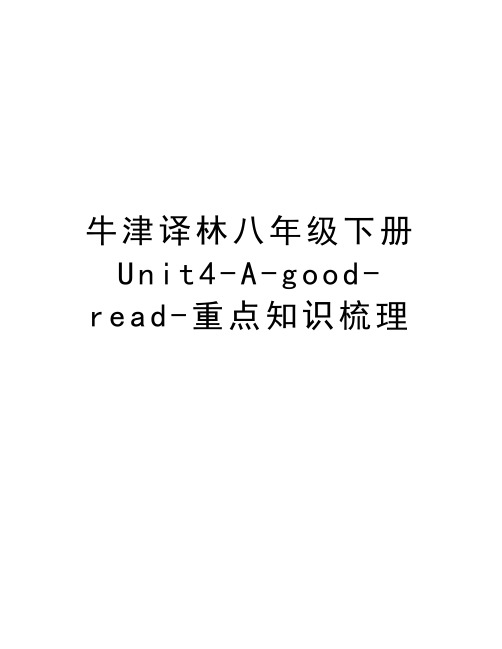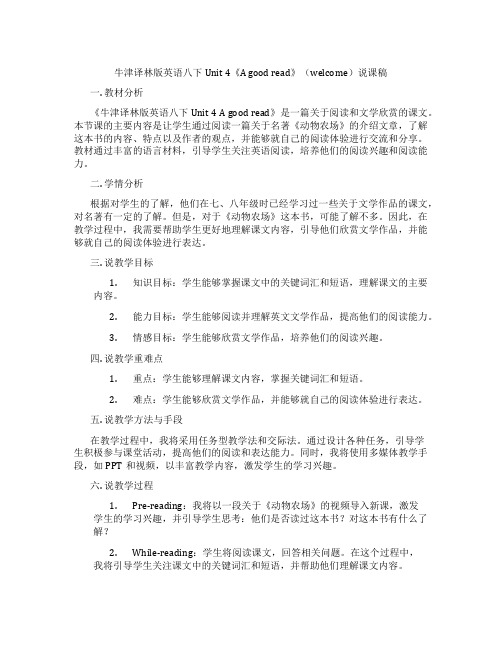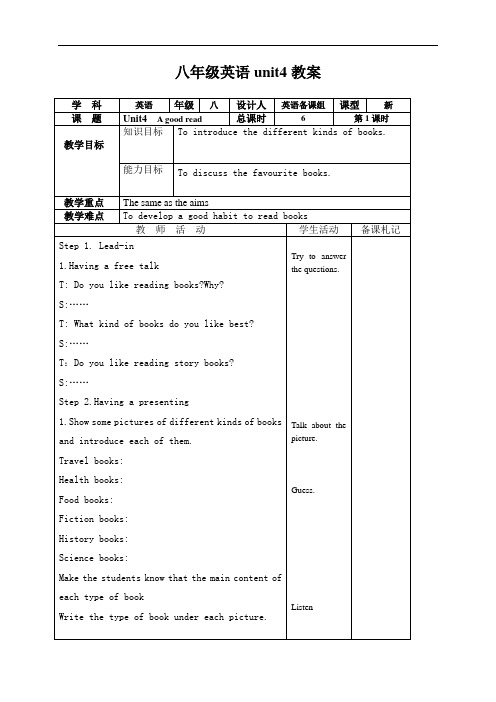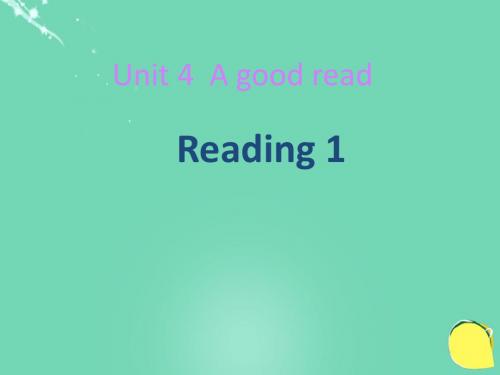江苏省仪征市第三中学牛津译林版八年级英语下册Unit 4 A good read 教案
- 格式:doc
- 大小:147.50 KB
- 文档页数:15

牛津译林八年级下册U n i t4-A-g o o d-r e a d-重点知识梳理8B unit4 A good read 知识梳理【重点短语】1. a charity show 一场慈善演出2 .the host of the charity show 慈善演出的主持人3.be chosen to be the monitor 被选为班长4. practise a lot 多加练习5. be sure 确信,肯定6. only if 除非7. advertise on the internet 在网上登广告8. give out the leaflets 分发传单9. donate money 捐钱10. organize a charity show 组织一场慈善演出11. sell…to…把…卖给…12. raise money 筹钱13. Project Green Hope 绿色希望工程(慈善机构)14.Project Hope 希望工程(慈善机构)15. Save China’s Tigers拯救中国虎(慈善机构)16. Spring Bud Project 春蕾计划(慈善机构)17. return to school(go back to school) 返回学校18. return sth to…(=give sth back to…)把…还给…19. big cats 大型猫科动物20. in poor areas 在贫困地区21. write to …写信给…22. hear from sb=receive a letter from sb 收到…的来信23. free time 空闲时间24.because of…(+名词、代词或动词-ing形式) 因为…25. TV cameras 电视镜头26. watch the show 看演出27.on time 准时28. in time 及时29. introduce sb to…把…介绍给…30. on duty 值日31. at the right time 在适合的时间32.at the same time 同时33. at the beginning of…在…开始时34. at the end of…在…结束时35. the big day 伟大的一天36. keep doing sth 一直做某事37. twenty minutes before the show 演出前20分钟38. get/ go into the theatre 进入剧场39. No time to be nervous any more 没有时间紧张了40. make noise 发出噪音41. become a little bit easier 变得有点容易了42. seem to do sth 似乎43. be over 结束44. a local business 当地企业45. have a lot of support 得到许多支持46. take part in 参加(活动)47. Best wishes 致以最美好的祝愿48. write down 写下,记下49. by mistake 弄错了50. at least 至少51. at most 最多52. It is a big success 真是太成功了53. help pay for their education 帮助支付他们的学费53.set up the stage 搭建舞台55. have a meeting/ hold a meeting 开会56. hold a charity show 举行慈善演出57. arrange work among the students 在学生中安排工作58. organize a play 组织剧本59. donations are welcome 欢迎捐赠60. thank the following for their help and support感谢下列提供我们帮助和支持的人61.on a snowy night 在一个下雪的夜晚62.from now on 从现在开始63.day and night 日日夜夜64.keep silent 保持沉默65.care about 关心【词汇拓展】1.cook v. → cooking (n.) 烹饪2.France n. → French(adj.) 法国(人)的3. write v. → writer(n.) 作家4.sell v. → sales (n.) 销售量[复]5. Canada n. → Canadian (adj.)6.confident adj. → confidence (n.)7. advise v. → advice (n.)8.stomach n. → stomachs (复数)9. able adj. → unable (反义词)10.hide v. → hidden (adj.) 隐藏的11. library n. → librarian (n.) 图书管理员12.class n. → classical(adj.) 古典的【重点句子】1.Have you decided what to do with these books, Hobo?霍波,你已经决定怎样处理这些书了吗?2. After our ship crashed against the rocks, I swam as far as I could.在我们的船触礁之后,我尽可能远地向前游。

牛津译林版英语八下Unit 4《A good read》(welcome)说课稿一. 教材分析《牛津译林版英语八下Unit 4 A good read》是一篇关于阅读和文学欣赏的课文。
本节课的主要内容是让学生通过阅读一篇关于名著《动物农场》的介绍文章,了解这本书的内容、特点以及作者的观点,并能够就自己的阅读体验进行交流和分享。
教材通过丰富的语言材料,引导学生关注英语阅读,培养他们的阅读兴趣和阅读能力。
二. 学情分析根据对学生的了解,他们在七、八年级时已经学习过一些关于文学作品的课文,对名著有一定的了解。
但是,对于《动物农场》这本书,可能了解不多。
因此,在教学过程中,我需要帮助学生更好地理解课文内容,引导他们欣赏文学作品,并能够就自己的阅读体验进行表达。
三. 说教学目标1.知识目标:学生能够掌握课文中的关键词汇和短语,理解课文的主要内容。
2.能力目标:学生能够阅读并理解英文文学作品,提高他们的阅读能力。
3.情感目标:学生能够欣赏文学作品,培养他们的阅读兴趣。
四. 说教学重难点1.重点:学生能够理解课文内容,掌握关键词汇和短语。
2.难点:学生能够欣赏文学作品,并能够就自己的阅读体验进行表达。
五. 说教学方法与手段在教学过程中,我将采用任务型教学法和交际法。
通过设计各种任务,引导学生积极参与课堂活动,提高他们的阅读和表达能力。
同时,我将使用多媒体教学手段,如PPT和视频,以丰富教学内容,激发学生的学习兴趣。
六. 说教学过程1.Pre-reading:我将以一段关于《动物农场》的视频导入新课,激发学生的学习兴趣,并引导学生思考:他们是否读过这本书?对这本书有什么了解?2.While-reading:学生将阅读课文,回答相关问题。
在这个过程中,我将引导学生关注课文中的关键词汇和短语,并帮助他们理解课文内容。
3.Post-reading:学生将就自己的阅读体验进行交流和分享。
在这个过程中,我将引导学生表达自己的观点,提高他们的表达能力。

牛津译林版八年级英语下册Unit4 a good read 课文要点解析Comic strip1.Have you decided what to do with these books, Hobo?霍波,你已决定怎样处理这些书了吗? (教材第48页)I)decide此处用作及物动词,意为“决定”,后跟名词、代词、动词不定式或从句等。
She decided to book two tickets to Hainan online.她决定在网上预订两张去海南的票。
Let's first decide where we should go.咱们先决定应该去什么地方。
[拓展]decide的名词形式是decision,意为“决定”。
make a decision (to do sth. )意为“做决定(做某事)”。
You need to make a decision today.你今天需要做个决定。
中考.链接(2017.江苏苏州).Jack, why have you decided_________Chinese folk music as a course?一To learn more about Chinese culture.A. takeB. takenC. takingD. to take解析:我们可用“固定搭配法”解答此题。
decide to do sth.为固定搭配,意为“决定做某事”,故选D。
句意:“杰克,你为什么决定选择中国民间音乐这门课”“为了更多地了解中国文化。
” 答案:D(2)do with意为“处理;处置;对待”,常与疑问词what连用。
What did you do with those old keyboards?你怎么处理那些旧键盘了?The new teacher didn't know what to do with students.那位新老师不知道如何对待学生。

八年级英语unit4教案学科英语年级八设计人英语备课组课型新课题Unit4 A good read总课时 6 第1课时教学目标知识目标To introduce the different kinds of books.能力目标To discuss the favourite books.教学重点The same as the aims教学难点To develop a good habit to read books教师活动学生活动备课札记Step 1. Lead-in1.Having a free talkT: Do you like reading books?Why?S:……T: What kind of books do you like best? S:……T:Do you like reading story books?S:……Step 2.Having a presenting1.Show some pictures of different kinds of books and introduce each of them.Travel books:Health books:Food books:Fiction books:History books:Science books:Make the students know that the main content of each type of bookWrite the type of book under each picture. Try to answer the questions.Talk about the picture.Guess.ListenCheck the answersStep 3.DiscussionListen to the tape and then answer the followingquestions1.What is Millie reading ?2.What does Sandy think about the history book?3.What kind of book does Sandy like?4.Was the story of the ugly man Quasimodo moving?Check the answersRead after the tapeWork in pairsStep 4. Comic stripListen to the tapeQuestionsRead after the tapeWork in pairsAct out the dialogueStep 5 Doing a taskDivide the stuents into four of a group and the do a survey about Which type of book would you like to read ?Give some reasons.What kind of book do you like?I like …Why ?Because …What about you ?I like … because …Look, listen andlearn.Make a conclusion and write a report Present the reportStep 6 Homework课堂板书教学反思学科英语年级八设计人英语备课组课型新课题Unit4 A good read总课时 6 第2课时教学目标知识目标To guess meanings of words from the context能力目标To skim the text for overall meanings and scan fordetails教学重点The same as the aims教学难点To skim the text for overall meanings and scan for details 教师活动学生活动备课札记Step 1. lead-inT: What kind of books do you like? S: T: Why S: T: Do you like fiction? S: T: Have you read a book called Gulliver’s Travels,by Jonathan Swift? Today we will learn something about it.Step 2. Presentation1.Present the new words and expressions2. Match the words on the left with the meanings on the right.Part B1,on page 453.Check he answers.Step 3.SkimmingSkim the text and then answer the following questions:1.Why was Gulliver so tired?2.What started climbing over Gulliver?Step 4. ScanningScan the text and then answer the following questions: Try to answer the questions.Talk about the picture.Guess.Look, listen andlearn.1.Why did Gulliver swim in the sea?2.Where did he fall asleep?3.Who was on Gulliver after he wake up?4.How big was the small man?5.How many tiny people climbed over Gulliver’s body?课堂板书教学反思学科英语年级八设计人英语备课组课型新课题Unit4 A good read总课时 6 第3课时教学目标知识目标To understand the structure of each passage.能力目标 1. To recite the passage.2.To develop a good habit to read books教学重点The same as the aims教学难点The same as the aims教师活动学生活动备课札记Step1.Review something about what we learntlast class1Why did Gulliver swim in the sea?2Where did he fall asleep?3Who was on Gulliver after he wake up?4How big was the small man?5How many tiny people climbed over Gulliver’s body? Step 2.DetailsRead the story and tell true or false. Part B3 on page 46.Ask the students to correct the mistakes Check the answersStep 3. Doing a taskSandy is trying to explain what happened to Gulliver. She wrote some notes down on a piece of paper, bu her mother tore it up by mistake. Help her match the events at the top with their causes at the bottom.Ask students to read and matchCheck the answersStep 4.Ask and answer Try to answer the questions.Talk about the picture.Guess.Look, listen andlearn.Complete the conversation with the informationon page 44,Part B4 on page 46Ask and answerStep5 Finding out all the useful expressionsGo over the text to find out all the usefulexpressions.1crash against2as 、、as3be tired out4the same size as5shout at sb6fall over7manage to doStep 6.Doing homeworka. Listen and read after the tape five times.b. Finish the exercises in the EvaluationHandbook.课堂板书教学反思学科英语年级八设计人英语备课组课型新课题Unit4 A good read总课时 6 第4课时知识目标掌握并能使用动词不定式与特殊疑问词连用教学目标能力目标掌握并能使用带有情态动词must和have to 用法区别教学重点动词不定式的用法和must , have to 两者的区别教学难点动词不定式的用法和must , have to 两者的区别教师活动学生活动备课札记Step1 Lead-in1.Review readinga.Did Gulliver know what to say?b.Did Gulliver know how to get away?2. Explain : We can use. “wh-”words + “to”infinitives to talk about problems.Step2 Presentation1.Present the following sentences:lie is decciding what to read.b.Daniel does not know who to talk to about this bookc.Simon forgot when to meet his friends.d.Kitty cannot decide which to choose friends.e.Sandy is windering where to ask for help.f.Amy does not know how to write the reprt.2.Ask the students to conclude the rules,and understand the mengings of the stucture: “wh-” words + “to” infinitives.3.Remind students that when we talk about “wh-” words, we mean question words. i.e., what, when, why, where, who, how4.Remind the students that all question words can be used in this way,except ‘why’.Step3 practice1.Explain to students that they need to use the “wh-“ words +to do structure to complete the exercise on page47.2.Once students have finished, choose one student to play the part of Amy and another student to play the part of Millie . Ask them to read the conversation aloud. Check for incorrect answers and mispronunciation. For weaker classes, ask several pairs of students to read one exchange each.Step4 Presentation1.Go on reviewing comic strip and reading to lead out thesentences with ‘must’ and ‘have to’.a.‘I must run away from them,’ Gulliver thought.b.I have to use them to reach the box on the fridge.2. Explain to the students that we use ‘must’ and ‘have to’ to say that it is necessary to do something . we use ‘must’ when the speaker feels that someting is cecessary. We use ‘have to’when the situation makes something cecessary.3.Present you must not smoke in the library. We do not have to Try to answer the questions.Talk about the picture.Guess.Look, listen andlearn.go to at weekends.Explain to the students we use ‘must not’to say that it isnecessary not to do something . we use ‘do not have to’ to saythat you are allowed not to do something.Step3 Exercises1.Finish the exercises on page 48, then check in pairs.Encourage students to explain the usage each other.Step5 Doing homework1.Revise“wh-” words + “to” infinitives.2.Finish off the exercise in the workbook.课堂板书教学反思学科英语年级八设计人英语备课组课型新课题Unit4 A good read总课时 6 第5课时知识目标听懂有关初中生课外读物的对话,并根据获取的信息完成表格教学目标能力目标能根据所听到的信息完成记录教学重点掌握一定的听的技巧,猜词速记等通过听力练习教给他们一些应试技巧教学难点掌握一定的听的技巧,猜词速记等通过听力练习教给他们一些应试技巧教师活动学生活动备课札记Step1 Presenting and listening1.Review the types of the books: fiction,history ,science ,travel,health , food etc.2.Ask the students what book they have read, talk about thethe names, characters and the stories of the books.Teacher can introduce some books to the students, such as:The Big World ,A Strange Egg, Follow Me , Last Century ,The Cecrets of Space, My Way to Success3.Part A Talking about what to read during the Reading Week . listen to them and match each student with the type of book they will read and its name.Then ask a student to read this part and check the answers together.Step2 Reading and listening1.Before listening the teacher tell the students informationabout Harry Potter books2.Ask the students to read the notes carefully and prepare tolisten3.Listen to the tape three times, the first time ask the studentsjust listen not to write , the second time listen and write ,and the teacher may pause if necessary, the third time check out the answers4.Ask a student to read this part and check the answerstogether.Step3 Listening and correcting1.Part A3 Millie made some notes about Suay’s reading plan.However, she has made some mistakes. Listen to Suzy again. Help Millie underline the mistakes in each sentence,write the correct words in the blank2.Listen and tell true or false, and then correct the mistakes.3.The teacher asks the students to share the answers with thewhole class.Step4 Part B Speak up.Listening and anwering Try to answer the questions.Talk about the picture.Guess.Look, listen andlearn.课堂板书教学反思学科英语年级八设计人英语备课组课型新课题Unit4 A good read总课时 6 第6课时教学目标知识目标To revise the whole unit, focusing on Grammar and Vocabulary能力目标To revise the whole unit, focusing on Grammar and Vocabulary教学重点To revise the whole unit, focusing on Grammar and Vocabulary教学难点To revise the whole unit, focusing on Grammar and Vocabulary教师活动学生活动备课札记Step 1 Having a revisionSome important words and phrases: a good read, stand against the wall, be tired out, continue to do(doing), manage to do, not…until…, either, hand in, refuse to doImportant sentences: How long can I keep the books? What is your favourite type of book?After our ship broke against the rocks.He was the same size as my little finger.I don’t know how to get away.Grammar: tell the difference between “must”and “have to”Using question words + ‘to’-infinitivesStep 2 Doing a survey on students’ reading habits Complete it with your own information Step 3 Sharing them with your classmatesStep 4 Part BWork in pairs. Ask each other the questions in the survey and take notes of the answersWrite a passage with the given exprssions I spend … hours a week reading.On weekdays I usually…I am interested in … books. My favourite book is …I get most of my books from…Try to answer the questions.Talk about the picture.Guess.I love reading because …Step 5 Part CAsking students to write an article about their reading habits.`Recite the passage about Millie’s reading habit.Step 6 Practise一.用适当形式填空1.I spend over four hours a week _______(read).2.Many people like reading before ______(go) to bed.3.It is cold outside, you’d better keep the door _____(close)4.It also _______(open) up a whole new world to me.5.I like the four great _______(class) Chinese novels best.二.完成句子1.这本书我能保存多长时间?_______________________2.你从一本书中怎样获得最多?____________________3.阅读是开心宁静的时刻。


Unit 4 A good read教学目标1 To study the new words that appear in the novel .2 To get the main idea of the passage.3 To develop students’ reading skills by both skimming and scanning.4. To improve students’ interest of reading famous novels.教学重难点1.To get the main idea of the passage.2.To develop students’ read ing skills by both skimming and scanning.3.To improve students’ interest of reading famous novels.课前准备课件录音机教师活动内容、方式学生活动内容、方式旁注Step 1 Show some famous novelsStep 2 Have a free talkQuestions:1. Are you interested in reading stories?2. What stories have you read?3. Why do you like them?4. Have you ever read the novel Gulliver ’s Travels? Step 3 Talk about the famous nove l. T:Gulliver’s Travels was written by the famou s British writer Jonathan Swift. This novel tells us Gulliver ’s amazing adventures in some countries, including Lilliput, Brobdingnag, Laputa and Houyhnhnms.Do you want to know more about this book? Step 4 Pre-reading1. Look and guess: What happened?2. Show some important elements of the article. Step 5 While-reading1.Read the first paragraph quickly and answer 1). What did Gulliver do after their shipcrashed against the rocks?2). Why did Gulliver fall down on the beach?2 Read paragraph 2 silently and do T or F questions1). When Gulliver woke up, it was almost evening.2). Someone tied Gulliver’s arms, legs, and hair to the ground.3.Read paragraph 3 with surprise .1}. Where was I?2). Who was this tiny person?4. Read paragraph 4 aloud and an swer.Why did the tiny men all fall over?1). Why did Gulliver shout at them?2). Did they care about Gulliver’s shout?3). Why didn’t they care?4). What do you think of the tiny men? Have a free talkListen to th e teacher carefully and learn some new words.Read the text and finish the following exercises.Imagine : If you are tiny men, whatdetermination will you talk about ?5. Read paragraph 5 and fill in the blanksHave a discussion :Could Gulliver run away at last?Tell your friends about the story.Step 6 Post-readingWhat do you think of Gulliver ?Step 7 Exercises用所给单词的适当形式填空1. How many __________ (手指) does a personhave?2. I don’t like playing computer games,________ (也)。
Unit 4 A good read教学目标知识与能力:1.To introduce the different kinds of books.2.To discuss the favourite books.过程与方法:1.to discuss what books are the Ss’ favourite in group.2.to talk about their favourite books in class.情感态度与价值观:To train the Ss’ interest in liking reading books.To develop a good habit to read books教学重点1.To introduce the different kinds of books.2.To discuss the favourite books.教学难点1.To introduce the different kinds of books.2.To discuss the favourite books.课前预习1.Preview the new words.2.Listen to the tape and read the dialogue.教学方法Listening 、reading、acting Discussing and pair work.教学用具Recorder and multimedia教学过程二次备课Step 1. Lead-in1.Having a free talkT: Do you like reading books?Why? S:……T: What kind of books do you like best? S:……T:Do you like reading story books? S:……Step 2.Having a presenting1.Show some pictures of different kinds of books and introduce eachof them.Travel books:Health books:Food books:Fiction books:History books:Science books:Make the students know that the main content of each type of bookWrite the type of book under each picture.Check the answersStep 3.DiscussionListen to the tape and then answer the following questions1.What is Millie reading ?2.What does Sandy think about the history book?3.What kind of book does Sandy like?4.Was the story of the ugly man Quasimodo moving?Check the answersRead after the tapeWork in pairsStep 4. Comic stripListen to the tapeQuestionsRead after the tapeWork in pairs.Act out the dialogueStep 5 Doing a taskDivide the stuents into four of a group and the do a survey about Which type of book would you like to read ?Give some reasons.What kind of book do you like?I like …Why ?Because …What about you ?I like … because…Make a conclusion and write a reportPresent the reportStep 6 Homework1. Read the text book and learn the new words and phrases by heart.2. Finish the exercises in the workbook.课堂达标一、A 根据句意及汉语提示完成单词。
牛津译林版英语八下Unit 4《A good read》(Grammar)教学设计一. 教材分析《A good read》是人教版牛津译林英语八年级下的一个单元,主题是关于书籍和阅读。
本课的主要内容是通过介绍两本书的评价,让学生学会如何使用过去时态和现在时态描述事件的顺序。
教材中包含了丰富的阅读材料,有助于提高学生的阅读兴趣和阅读能力。
二. 学情分析学生在学习这个单元前,已经掌握了动词的过去式和现在式的变化规则,同时也具备了一定的阅读理解能力。
但学生在阅读长篇文章时,可能会遇到生词和难句,影响阅读理解。
因此,在教学过程中,需要帮助学生克服这些困难,提高他们的阅读能力。
三. 教学目标1.知识目标:学生能够正确使用过去时态和现在时态描述事件的顺序。
2.能力目标:学生能够读懂文章,提高阅读理解能力。
3.情感目标:激发学生对阅读的兴趣,培养良好的阅读习惯。
四. 教学重难点1.重点:学生能够正确使用过去时态和现在时态描述事件的顺序。
2.难点:学生能够读懂文章,提高阅读理解能力。
五. 教学方法1.任务型教学法:通过完成各种任务,激发学生的学习兴趣,提高学生的参与度。
2.互动式教学法:教师与学生,学生与学生之间的互动,促进知识的传递和能力的培养。
3.情境教学法:创设情境,让学生在真实的环境中学习,提高学生的应用能力。
六. 教学准备1.教师准备:准备好教材、多媒体教具、教学卡片等教学资源。
2.学生准备:学生提前预习课文,了解文章大意。
七. 教学过程1.导入(5分钟)教师通过提问方式引导学生谈论他们喜欢的书籍和阅读体验,激发学生的学习兴趣。
2.呈现(10分钟)教师通过多媒体展示两本书的评价,让学生听懂并理解文章的内容。
3.操练(15分钟)学生分角色朗读文章,模仿文章中的评价语言。
教师引导学生运用过去时态和现在时态描述事件的顺序。
4.巩固(10分钟)学生分组讨论,总结文章的主旨大意,并用自己的话进行表达。
教师巡回指导,纠正学生的错误。
牛津译林版英语八下Unit 4《A good read》(integrated skills)说课稿一. 教材分析《牛津译林版英语八下Unit 4 A good read》是一篇关于阅读理解和文学鉴赏的课文。
本节课的主要内容是让学生通过阅读一篇关于小说《动物农场》的评论文章,提高学生的阅读理解能力,同时培养学生的文学鉴赏素养。
教材中包含了丰富的语言知识,如词汇、语法和阅读策略,为学生提供了全面的语言学习材料。
二. 学情分析在八年级下学期的学生已经具备了一定的英语基础,能够理解和运用基本的英语语法和词汇。
然而,他们在阅读理解方面还存在一定的困难,特别是对于长篇复杂的文章。
此外,由于学生对文学作品的接触较少,他们在文学鉴赏方面的素养还有待提高。
因此,在教学过程中,教师需要关注学生的阅读理解能力和文学鉴赏素养的提升。
三. 说教学目标1.知识目标:学生能够掌握课文中的关键词汇和语法知识,如现在完成时、被动语态等。
2.能力目标:学生能够提高阅读理解能力,能够运用阅读策略理解长篇复杂的文章。
3.情感目标:通过阅读和讨论,学生能够培养对文学作品的鉴赏能力,激发对阅读的兴趣。
四. 说教学重难点1.重点:学生能够理解课文内容,掌握关键词汇和语法知识。
2.难点:学生能够运用阅读策略理解长篇复杂的文章,提高阅读理解能力。
五. 说教学方法与手段1.教学方法:采用任务型教学法,让学生在完成任务的过程中提高语言运用能力。
2.教学手段:利用多媒体课件、纸质教材和网络资源等,为学生提供丰富的学习资源。
六. 说教学过程1.导入:通过提问学生喜欢的书籍和作家,激发学生对文学作品的兴趣,引入本节课的主题。
2.阅读理解:学生自主阅读课文,回答相关问题,教师引导学生运用阅读策略理解文章。
3.词汇语法:学生通过课文学习新词汇和语法知识,教师进行讲解和练习。
4.小组讨论:学生分组讨论课文中的观点和表达方式,培养学生的批判性思维能力。
5.文学鉴赏:教师引导学生分析课文中的文学手法和特点,提高学生的文学鉴赏素养。